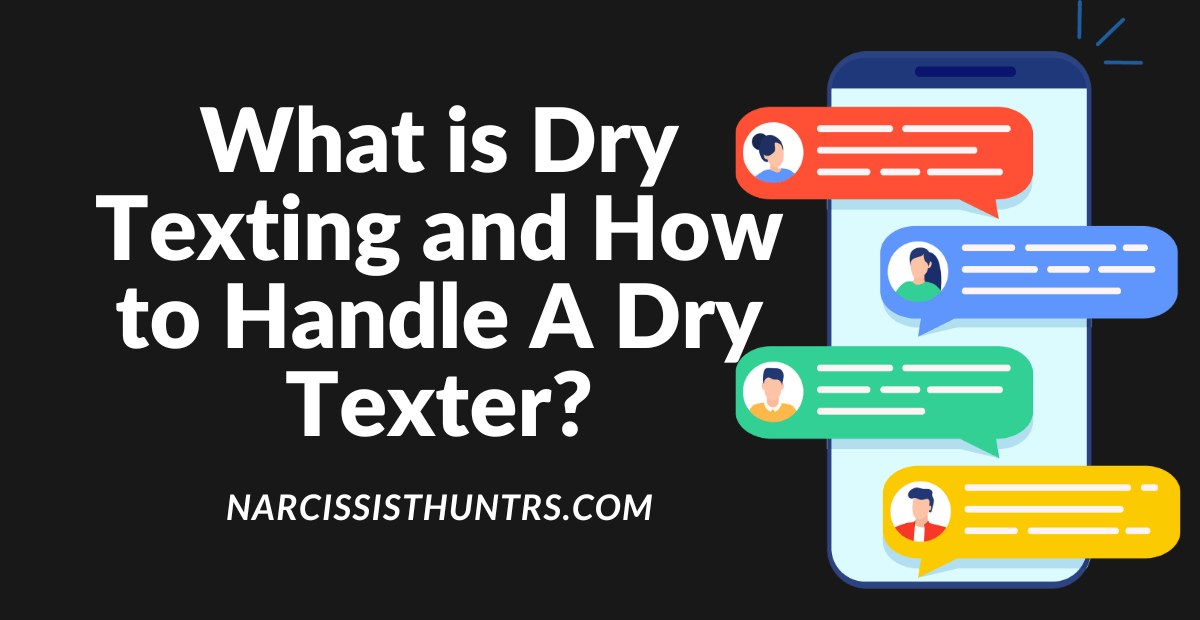Are your text conversations feeling dull and lifeless lately? If you find yourself sending messages that are met with short, unengaging responses, you may be dealing with a dry texter. In today’s digital age, dry texting has become a common communication issue that can leave you feeling frustrated and disconnected.
But fear not, in this blog post we’ll explore the world of dry texting and provide strategies to keep the conversation flowing, inject personality into your texts, and engage with even the driest of texters. Read on to improve your digital communication skills and build stronger relationships.
What is Dry Texting?
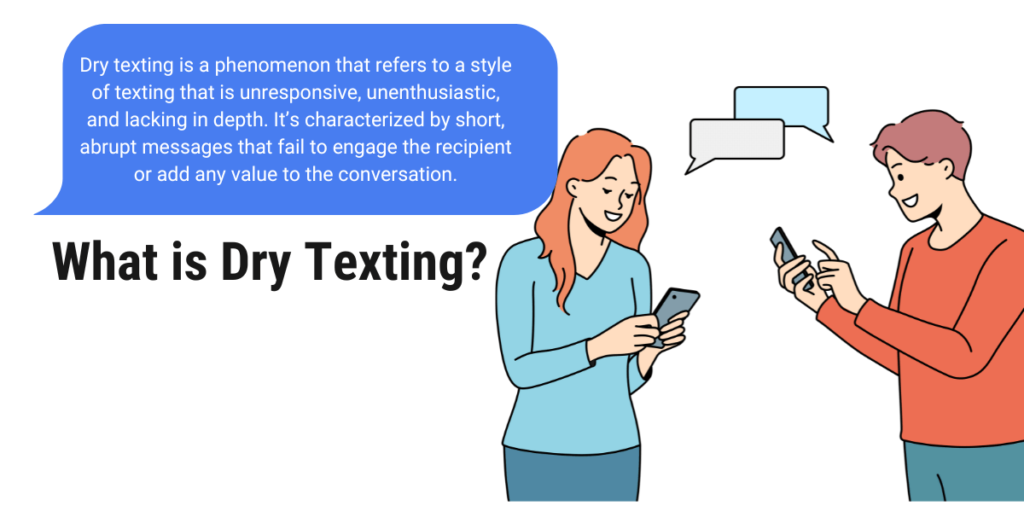
Dry texting is a phenomenon that refers to a style of texting that is unresponsive, unenthusiastic, and lacking in depth. It’s characterized by short, abrupt messages that fail to engage the recipient or add any value to the conversation. Dry texting is often seen as a sign of disinterest or lack of effort, and can be a source of frustration and miscommunication in relationships.
But in a funny way , we can say Dry Texting is:
- “Dry texting is like eating toast without butter – it’s just plain and unsatisfying.”
- “If dry texting was a sport, it would be the equivalent of playing ping pong with a wall.”
- “Dry texting is what happens when a robot tries to flirt.”
- “Dry texting: the quickest way to make a conversation as exciting as watching paint dry.”
- “Dry texting is like trying to have a conversation with a piece of cardboard.”
Dry Texter Meaning

A dry texter is someone who tends to respond to text messages with short, unengaging, and unemotional messages that don’t add much to the conversation. A dry texter may also take a long time to respond to messages, which can make it difficult to maintain a fluid conversation.
This behavior can make it challenging for others to engage in a meaningful conversation with them and can sometimes be perceived as a lack of interest or effort in the relationship.
Examples of Dry texting
Some examples of dry texting include:
- “K” as a response to a message that required a longer answer.
- “Sure” as a response to an invitation or suggestion.
- “lol” or “haha” as a response to something that isn’t actually funny.
- “Whatever” as a dismissive response to an argument or disagreement.
- “I guess” as a half-hearted response to a question or decision.
- “Yup” or “Nope” instead of a more complete response.
- “IDK” as a response to a question instead of trying to find an answer.
- “OK” as a way to end a conversation without expressing any interest or enthusiasm.
How to Identify a Dry Texter?

Identifying a dry texter can be a challenge, particularly if you have never met them in person or are not familiar with their communication style. However, there are several signs to watch out for, including:
- Short, one-word responses – They reply to your novel-length message with “k.”
- Failure to elaborate on their thoughts or feelings – They use more periods than a high school English teacher.
- Silence or a long delay in response time – WAIT, WAIT, Wait.
- Disinterest in the conversation topic -When you get a message from them, it’s like a desert breeze – dry and lifeless.
- They never use emojis, unless it’s the sad face or the thumbs down.
- Their messages are so dry, you need a glass of water just to get through them.
Reasons why people Dry Text In Relationships
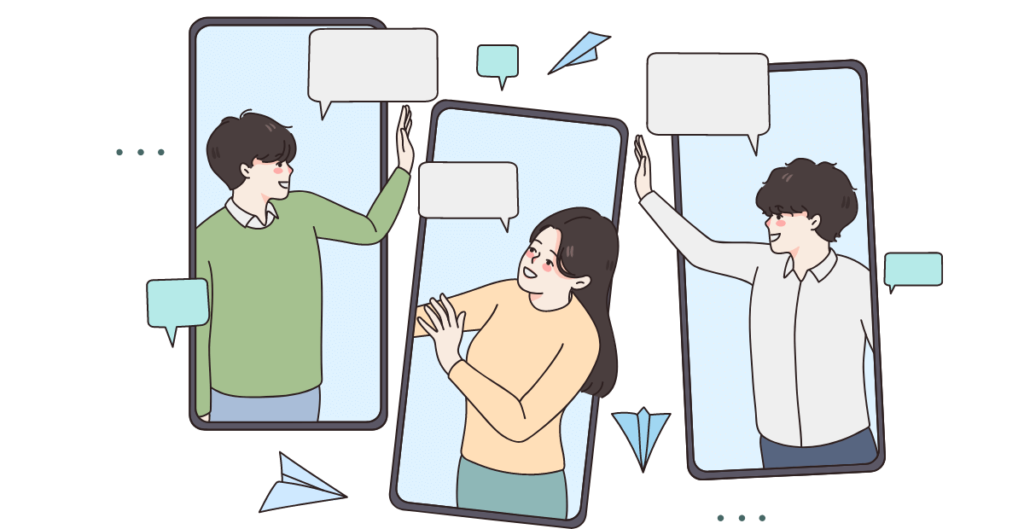
There are many reasons why people might engage in dry texting in relationships. Some of the most common reasons include:
- Anger: People may dry text in relationships out of anger as a way to express their displeasure without confronting the issue directly or to intentionally distance themselves emotionally.
- Lack of interest: If someone is not interested in the relationship or is simply not interested in the other person, they may engage in dry texting as a way to avoid having to engage in deeper conversation or emotional connection.
- Avoidance of conflict: Some people may use dry texting as a way to avoid conflict or difficult conversations. By keeping the conversation surface-level and unengaging, they can avoid potential arguments or uncomfortable topics.
- Communication style: Some people simply have a more reserved or introverted communication style (Introverted people speak less) and may not be comfortable engaging in more dynamic or engaging conversations.
- Busy schedules: Similar to the reasons discussed earlier, busy schedules can make it difficult for people to engage in longer, more involved conversations. In these cases, dry texting may be seen as a necessary compromise.
Regardless of the reason behind the behavior, it’s important to recognize that dry texting can have a significant impact on relationships. By understanding the potential consequences and working to avoid this behavior, we can build stronger, more meaningful connections with the people in our lives
Damaging impacts Of Dry Texting On The Relationships
Sure! Here are some of the damaging effects that dry texting can have on relationships:
- Miscommunication: Dry texting can lead to miscommunication and misunderstandings, as the lack of engagement and effort in the conversation can make it difficult to convey meaning or intent.
- Lack of emotional connection: Texting is a primary mode of communication in many modern relationships, and when one person engages in dry texting, it can make the other person feel undervalued and unimportant, leading to a lack of emotional connection.
- Frustration: When one person consistently engages in dry texting, it can be frustrating for the other person, who may feel like they are putting in more effort than their partner.
- Decreased relationship satisfaction: Dry texting can lead to decreased relationship satisfaction, as the lack of engagement and effort in the conversation can make the other person feel unappreciated and unloved.
- Negative impact on mental health: For some people, the impact of dry texting can go beyond just the relationship itself, leading to feelings of anxiety, depression, or other negative mental health outcomes.
Overall, dry texting can have a significant impact on relationships, leading to feelings of disconnection, frustration, and even resentment. By recognizing the damaging effects of this behavior and working to avoid it, we can build stronger, more meaningful connections with the people in our lives.
How Not To be a Dry Texter?
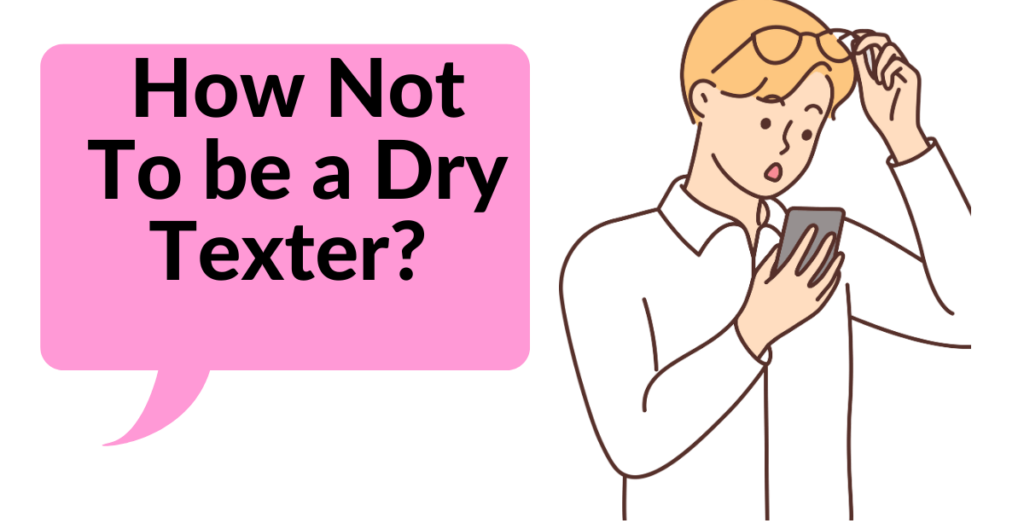
Sure! Here are some tips for not being a dry texter and keeping the conversation flowing:
1. Ask open-ended questions
Instead of just sending one-word responses or closed-ended questions, ask open-ended questions that require a more detailed response. This can help to spark a more engaging conversation and show that you’re interested in what the other person has to say.
Examples of open-ended questions
Open-ended questions are designed to encourage elaboration and deeper conversations. Some examples are:
- What inspired you to pursue your current career?
- How do you usually spend your weekends?
- What do you think about [current event or news topic]?
- What are your thoughts on [a particular idea or concept]?
- Can you describe a challenge you faced and how you overcame it?
- What are some of your favorite hobbies or activities?
- How do you usually approach problem-solving?
- What is something you’ve always wanted to try or learn?
- Can you tell me more about your background or upbringing?
- How do you usually cope with stress or difficult situations?
2. Share your thoughts and feelings
When you receive a message from someone, take the time to respond thoughtfully and share your own thoughts and feelings on the topic. This can help to keep the conversation flowing and show that you’re engaged in the conversation.
Here are some examples of how to share your thoughts and feelings
- “I’m really excited to see you later today! It’s been too long since we’ve hung out.”
- “I was feeling a little down earlier, but talking to you always cheers me up. Thank you for being there for me.”
- “I’ve been thinking a lot about our conversation yesterday and I wanted to let you know that I appreciate your perspective. It gave me a lot to think about.”
- “I’m sorry if I came across as cold or distant in my last message. I was feeling a little overwhelmed, but I want you to know that I value our friendship and I’m here for you.”
- “I just wanted to check in and see how you’re doing. Is there anything you want to talk about or share?”
Remember, the key to sharing your thoughts and feelings effectively is to be honest, genuine, and respectful. Don’t be afraid to open up and show vulnerability, and try to actively listen to the other person’s response.
3.Show interest in the other person
If you want to keep the conversation going, show that you’re interested in the other person by asking questions about their life, interests, and hobbies. This can help to build a stronger connection and make the conversation more engaging.
Here are some examples of how to show interest in the other person:
- “How was your day today? Did anything interesting happen?”
- “I saw [an article, a movie, a TV show] that reminded me of you. Have you seen/heard of it?”
- “I noticed that you’ve been posting a lot of pictures from your travels on social media. Where is your favorite place you’ve visited?”
- “You mentioned that you’re really into cooking. What’s your favorite dish to make?”
- “I’ve been wanting to learn more about [a topic the other person is interested in]. Do you have any book or podcast recommendations?”
4. Use humor In Texts
Humor can be a great way to keep the conversation light and engaging. Try to inject some humor into your messages when appropriate, but be careful not to overdo it or make inappropriate jokes.
Here are some examples of how to use humor in texts:
- “Why don’t scientists trust atoms? Because they make up everything.”
- “I’m trying to come up with a witty response to your last message, but my brain is on a coffee break. Can I get back to you later?”
- “Do you know what’s really ironic? I have a fear of speed bumps, but I drive a really low car.”
- “I just saw a squirrel burying a nut in my yard and I was like, ‘dude, it’s spring. You missed your chance.'”
- “I was going to tell you a joke about pizza, but it was a little cheesy.”
5.Use emojis and gifs in texts
Emojis and gifs can be a fun and lighthearted way to express your emotions and keep the conversation flowing. Just be careful not to overuse them, as this can make your messages seem juvenile or insincere.
Here are some examples of how to use them:
- If someone asks you to hang out and you’re excited to go, respond with a “thumbs up” or “party” emoji.
- If you want to show gratitude or appreciation, use a “heart” or “thank you” emoji.
- If someone sends you a funny joke, respond with a laughing/crying emoji or a GIF that expresses your amusement.
- If you want to express your excitement about something, use a “fire” or “heart eyes” emoji.
- If you’re feeling sarcastic or teasing, use a “winking” or “smirking” emoji.
By following these tips, you can avoid being a dry texter and engage in more dynamic and engaging conversations with the people in your life. Remember, effective communication is key to building strong, meaningful relationships, both online and offline.
Some people have habit they get dry during the conversation or in mid of conversations, if you are one of these people next section is for you.
How to Not Be Dry When Texting ?
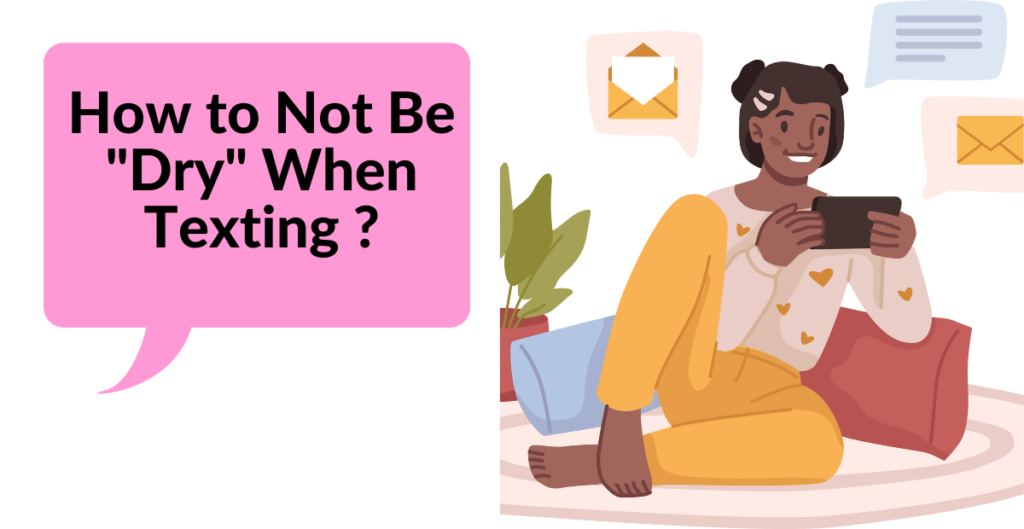
Sure! Here are some tips for not being dry when texting:
1. Inject personality into your texts
Instead of just sending generic, one-word responses, try to inject some personality into your texts by using humor, sarcasm, or sharing interesting stories. This can help to make the conversation more engaging and show that you’re interested in the other person.
2. Use proper grammar and spelling
While it may seem minor, using proper grammar and spelling can make a big difference in how your texts are perceived. Avoid using shorthand or slang that may be difficult for the other person to understand.
3. Respond in a timely manner
While you don’t need to respond immediately to every message you receive, it’s important to respond in a timely manner to show that you’re interested in the conversation and value the other person’s time.
4. Avoid using too many acronyms or emojis
While emojis and acronyms can be a fun way to express yourself, using too many of them can make your messages seem juvenile or unprofessional.
5. Be respectful of the other person’s time
If the other person is busy or doesn’t seem interested in continuing the conversation, don’t continue to send messages. Respect their time and move on to another conversation or activity.
Dos and don’ts of texting etiquette
- Do: Use proper grammar and spelling
- Do: Respond in a timely manner
- Do: Show interest in the other person
- Don’t: Send messages that are too long or overwhelming
- Don’t: Use all caps or excessive punctuation
- Don’t: Send too many messages in a row without waiting for a response
By following these tips and practicing good texting etiquette, you can avoid being dry when texting and build stronger, more meaningful connections with the people in your life.
How to Text a Dry Texter ? Tips for engaging with someone who tends to dry text
Here are some tips for texting a dry texter and keeping the conversation interesting:
- Don’t take it personally: If someone tends to dry text, it’s important not to take it personally or assume that they’re not interested in the conversation. Some people simply prefer to communicate in other ways, such as in-person or over the phone.
- Ask open-ended questions: As we mentioned earlier, asking open-ended questions can help to spark a more engaging conversation. Try to ask questions that require more than just a simple “yes” or “no” answer.
- Share interesting stories or facts: If you want to keep the conversation flowing, try sharing interesting stories or facts that you think the other person might find engaging. This can help to keep the conversation interesting and enjoyable.
- Use positive language: Instead of focusing on negative topics or complaining, try to use positive language and focus on the good things happening in your life. This can help to keep the conversation light and enjoyable.
- Be patient: If the other person tends to dry text, it’s important to be patient and not get frustrated. Remember that everyone communicates differently and it may take some time to build a rapport and find common ground.
10 Texts To Open up a Dry Texter
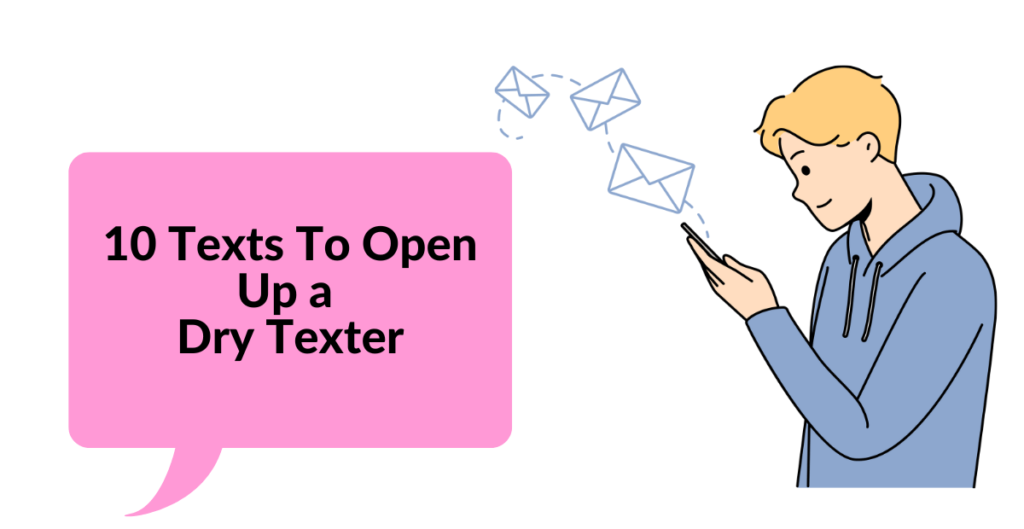
Here are ten examples of texts that you can use to try and open up a dry texter:
- “Hey, I was thinking about that thing we talked about the other day. What do you think about [insert topic here]?”
- “I heard about [insert current event or interesting news story], what are your thoughts on it?”
- “What are your favorite hobbies or interests? I’m trying to get to know you better.”
- “I’ve been listening to this great podcast lately, have you listened to any good ones recently?”
- “What’s something that always puts a smile on your face?”
- “I’m in the mood for something fun this weekend, any suggestions on what we could do?”
- “What’s your favorite movie of all time? I’m looking for some recommendations.”
- “I’m feeling a little down today, can you send me a funny meme or video to cheer me up?”
- “What’s your favorite place to travel to? I’m making a travel bucket list and looking for inspiration.”
- “Hey, I know we’ve been texting back and forth, but would you be interested in having a phone or video call to chat? I’d love to hear your voice/see your face.”
By following these tips and strategies, you can engage with a dry texter and keep the conversation interesting and enjoyable for both of you. Remember, effective communication is key to building strong relationships, both online and offline.
Final Thoughts
In conclusion, dry texting is a communication phenomenon that can have a significant impact on relationships. Whether you’re dealing with a chronic dry texter or trying to avoid becoming one yourself, it’s important to understand the common causes of dry texting and the strategies for avoiding it.
By following the tips and techniques outlined in this post, you can improve your digital communication skills and build stronger, more engaging relationships. Remember, communication is a two-way street, and it takes effort from both parties to keep the conversation flowing.
With a little patience and practice, you can avoid the pitfalls of dry texting and enjoy more meaningful interactions with the people in your life.
